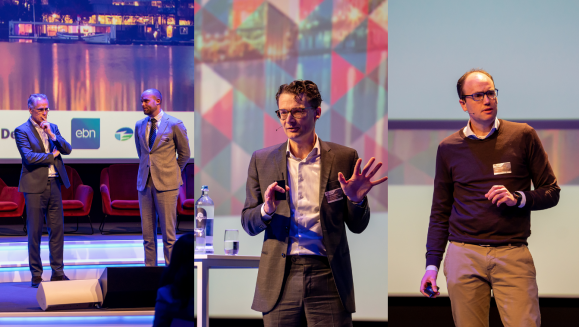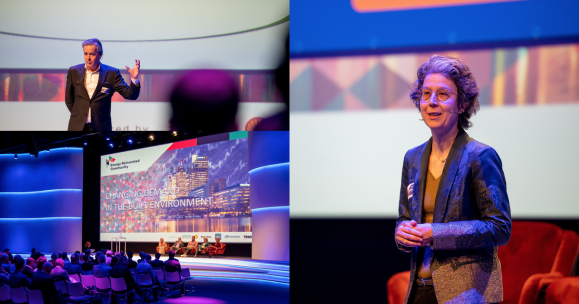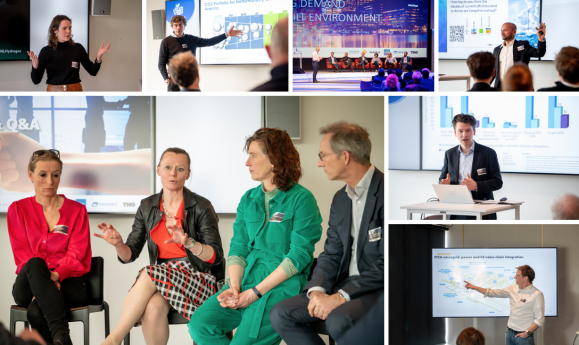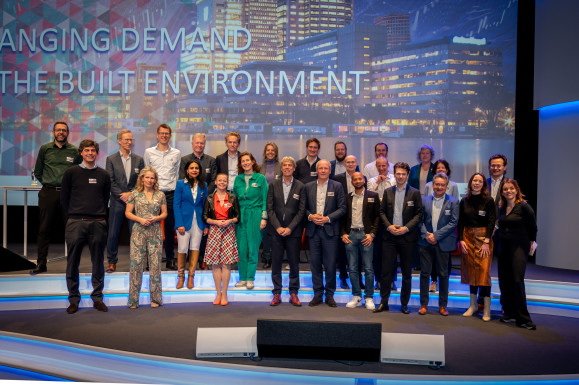
REPORT ERC EVENT 7 MARCH CHANGING DEMAND IN THE BUILT ENVIRONMENT
On Thursday 7 March around 150 ERC members gathered in the fully renovated NBC congress center in Nieuwegein for the first event based on this year’s theme “FOCUS ON DEMAND”.
The focus for the day was Changing demand in the built environment.
The built environment makes up almost 30% of final energy demand in The Netherlands and natural gas is still the most important energy source for heat and power. Changing demand in the built environment is characterized by a need to reduce, replace and balance. Meeting these needs requires concerted actions at different levels, from individual households to small businesses, from municipalities to national government. The good news: there is a willingness to change at all levels. The reality check: many players lack information, or means, or both, to make the change happen at the required or even desired pace.
Driving demand change
ERC partners TNO and EBN hosted this year’s first event. Henk-Jan Vink, Managing Director Energy and Materials Transition at TNO and Douwe van Leverink, Director Energy Systems at EBN opened the plenary session. Henk-Jan Vink emphasized the need to listen carefully to questions and concerns from individual households and not simply tell and prescribe. Douwe Leverink added that it’s important to be aware that while financial incentives help drive change, we should not underestimate how people can be intrinsically motivated to change.

What change are we talking about then? The 2019 Climate Agreement includes a commitment to reduce CO2 emissions in the built environment. In 2050, 7 million houses and 1 million buildings should be disconnected from the natural gas grid. The intermediary target is 1,5 million houses in 2030. The first step is energy conservation. Simple and practical insulation measures can significantly reduce energy use. The second step is to electrify what can be electrified and replace gas with renewable energy sources. Which leads to the third step and that is to balance energy demand.
Demand flexibility
Reinier Koppelaar is deputy director Energy Market at the Ministry of Economic Affairs and Climate Policy and responsible for heat and energy saving policy development. Koppelaar presented an overview of policy instruments and supporting subsidy and tax schemes at national and municipal level to support energy transition in the built environment. He argued that in creating a secure, affordable and sustainable energy system, there are differences between the user perspective and the system perspective. “What makes sense for an individual user may have negative consequences for the system and what makes sense from a system perspective may be perceived as too expensive or restrictive, for example heat pumps versus district heating,” said Koppelaar.
Local electricity use and production is another area where individual choices and system considerations can clash. “When energy is used will become more important than how much is used,” said Koppelaar. “At the moment we are used to electricity being available 24/7 but in future we will be more dependent on intermittent sources. This will require demand flexibility.” Koppelaar was also very critical of the use of hydrogen in the built environment, as he sees multiple more efficient options to decarbonize.
Impact of local efforts
David Peters, CTO of grid operator Stedin, confirmed this and elaborated. “Electricity usage is rapidly increasing. We are using more electricity to heat buildings, for electric cars and industrial applications.” Combined with strong PV growth, both on rooftops and solar parks, this puts pressure on the electricity grid. “At the moment we’re pushing the grid to the limit,’ said Peters. “That’s why grid optimization – doing everything we can with the current system – and grid management – ensuring high service reliability” are crucial.
Stedin and other grid operators are investing heavily in the grid. Stedin alone will invest EUR 924 million to realize 400 new transformer stations and 700 kilometer of power cable. But the speed of execution is not what it needs to be and Peters said he sees a gap between what Stedin can do and what Stedin needs to do to meet demand. This also has to do with what customers generate and want to feed back to the grid.
That is why Stedin has started a campaign to educate its customers and to create awareness for the impact of local efforts. “We don’t want to shut off customers, we want customers to understand the role of balancing demand. It can really make a difference to charge your car outside peak hours and to try to use the energy you generate.” Stedin recently received a lot of media attention for its proposal to shut off public charging points in cities during peak hours to reduce stress on the grid.
Standardization, for example for new substations, can also help. “There is something to say for the Henry Ford approach, “you can chose between black and green, not more’’ then you can really accelerate. If everybody wants customized solutions, that will slow you down.”
Speeding up heat transition
Peters is not alone in arguing for standardization. Hans Otten, Partner at Fakton Energy, a consultancy focused on finance, real estate and energy transition, thinks it’s time for a standard approach to develop district heating. “Municipalities are in the lead to change heat demand. They are all developing their own solutions. But with a standard approach they don’t all have to reinvent the wheel.”
The current implementation rate for district heating networks is lagging behind. “The Netherlands agreed to 900,000 new district heating connections for existing buildings by 2030. We are currently around 400,000 connections, meaning that 100,000 new connections must be realized each year for the next five years.”
Otten has a vision of new forms of collaboration, which has already come true with GWIB (Gelders Warmte Infra Bedrijf). GWIB is a new public entity that supports individual municipalities in developing, installing and maintaining district heating systems by providing knowledge, expertise, capacity and capital. “Municipalities can’t do it on their own,” said Otten. “Collaboration with industry is needed, ideally around a portfolio of projects instead of standalone projects.” This can increase implementation at lower cost and accelerate learnings.

Attention, enablers, intention
A common theme when talking about changing demand is human behavior. Nicole de Koning is Program leader Social innovation and the energy transition at TNO and shared the latest research insights on behavioral aspects of energy demand. Behavioral change can be difficult, but the majority of respondents in a recent study is willing to contribute in energy transition. “What’s important to realize, is that money is not the only and not the most important incentive for behavioral change,” said De Koning. In some cases people even make choices that are financially unattractive. “Convenience, social recognition or approval and doing something for others can be important drivers as well.”
Regardless of the desired change, policy makers and businesses do well to follow a three-way model of attention, enablers and intention. De Koning illustrates this for the case of disconnecting homeowners from the natural gas grid. Homeowners need to be involved at the right time and be given a concrete reason to establish a sense of urgency and with that, attention. Homeowners need to be equipped to take natural gas-free measures, for example by providing sufficient knowledge and certainty on legislation and policy. These are the enablers. Finally, homeowners need to see what makes the alternative attractive to them. This supports the right intention for change. “The conclusions of our research seem generally applicable,” according to De Koning, “Pay attention to people and their environment, be reliable, make it as easy as possible for people to change.”
Learning from others
What then, are tangible solutions to realize change? Sophie van den Enk moderated a panel discussion with experts from different backgrounds:
- Annelies Huygen, Professor Regulation of energy markets at Utrecht University and principal consultant at TNO Strategy & Policy;
- Ismaïl Sarti, Secretary JongRegio, an organization representing the voice of young people in energy transition;
- Wendy Dubbeld, Program Manager Stichting Warmtenetwerk, a foundation bringing together public and private parties in heat transition;
- Bente Vedder, Deputy Head of Energy Transition Built Environment at Ministry
- of the Interior and Kingdom Relations and
- Roelof Potters, Program manager district heating at Alliander.
Their discussion addressed the roles, responsibilities and options of different players in energy transition and what we can learn from other transitions – for example going from coal to natural gas – and from other European countries, also when it comes to the costs of energy transition and changing consumer fees. We should also do well to keep cooling in mind and not only power and heating.

Focus groups
Thursday’s event offered as many as six focus group sessions including two new sessions. The new Focus group Hydrogen was organized in collaboration with Joyce Conings, Program Coordinator at NLHydrogen Association. Building on the plenary discussion, this session concluded that hydrogen in the built environment is not likely but should not be ruled out either, in certain regions this could be considered a real option.
The other new focus group was Financing the energy transition led by Michiel Engelaar, Director Sustainable Finance Team at Deloitte. Floor Gorden, Alderman of the municipality of Amstelveen gave a clear presentation of how Amstelveen supports energy transition and engages its citizens and supports pioneers.
Watch this space and the website for more insights from these and the other focus group sessions!
New focus group: System integration
The event ended with the announcement of a new working group on System integration by Andreas ten Cate of ISPT. At the next event on the 4th of June, ERC members can also take part in this focus group.

Upcoming Energy Reinvented Community events
Preparations are already underway for the other ERC events this year:
- 4 June 2024 the theme will be Matching energy supply and demand for our industry
- 14 November 2024 Decarbonization pathways for transport.
All presentations as well as a summary video of the day and the photos taken can be found at the website www.energyreinventedcommunity.com by using the black button VIEW ON WEBSITE. This button is shown both at the top and bottom of this email. Or login with your personal login code. Go to FORUM, select EVENTS and select 2024-03 CHANGING DEMAND IN THE BUILT ENVIRONMENT.
Looking forward to meeting you at our next event on 4 June about Matching energy supply and demand for our industry, hosted by Siemens Energy and TenneT.





